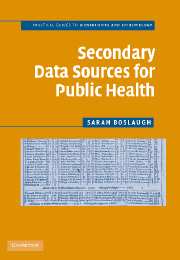Crossref Citations
This Book has been
cited by the following publications. This list is generated based on data provided by Crossref.
Shmueli, Galit
and
Koppius, O.
2009.
The Challenge of Prediction in Information Systems Research.
SSRN Electronic Journal,
Shamblen, Stephen R.
and
Dwivedi, Pramod
2010.
Is some data better than no data at all? Evaluating the utility of secondary needs assessment data.
Drugs: Education, Prevention and Policy,
Vol. 17,
Issue. 6,
p.
835.
Kenett, Ron S.
and
Shmueli, Galit
2012.
On Information Quality.
SSRN Electronic Journal,
Emerson, Eric
Felce, David
and
Stancliffe, Roger J.
2013.
Issues Concerning Self-Report Data and Population-Based Data Sets Involving People With Intellectual Disabilities.
Intellectual and Developmental Disabilities,
Vol. 51,
Issue. 5,
p.
333.
Ilott, Irene
Gerrish, Kate
Booth, Andrew
and
Field, Becky
2013.
Testing the Consolidated Framework for Implementation Research on health care innovations from South Yorkshire.
Journal of Evaluation in Clinical Practice,
Vol. 19,
Issue. 5,
p.
915.
Roth, Aleda
Gray, John
Shockley, Jeff
and
Weng, Hua-Hung (Robin)
2013.
The Use of Secondary Source Data for Measuring Performance in Operations Management Research.
SSRN Electronic Journal,
Hwu, Fenfang
2013.
A review of the use of script-based tracking in CALL research for data sharing: applications providing meaning aids.
Computer Assisted Language Learning,
Vol. 26,
Issue. 4,
p.
350.
Muth, Rodney
Browne-Ferrigno, Tricia
Bellamy, Thomas
Fulmer, Connie
and
Silver, Michael
2013.
Using Teacher Instructional Leadership as a Predictor of Principal Leadership.
Journal of School Leadership,
Vol. 23,
Issue. 1,
p.
122.
Mark Freestone and Dr Stijn Vandevelde, Dr
Wittouck, Ciska
Dekkers, Anne
Vanderplasschen, Wouter
and
Vander Laenen, Freya
2014.
Psychosocial functioning of drug treatment court clients: a study of the prosecutor's files in Ghent, Belgium.
Therapeutic Communities: The International Journal of Therapeutic Communities,
Vol. 35,
Issue. 3,
p.
127.
Curty, Renata Gonçalves
and
Qin, Jian
2014.
Towards a model for research data reuse behavior.
Proceedings of the American Society for Information Science and Technology,
Vol. 51,
Issue. 1,
p.
1.
Cheyney, Melissa
Bovbjerg, Marit
Everson, Courtney
Gordon, Wendy
Hannibal, Darcy
and
Vedam, Saraswathi
2014.
Outcomes of Care for 16,924 Planned Home Births in the United States: The Midwives Alliance of North America Statistics Project, 2004 to 2009.
Journal of Midwifery & Women's Health,
Vol. 59,
Issue. 1,
p.
17.
Appiah-Padi, Radecka
2014.
Job Desirability.
Sage Open,
Vol. 4,
Issue. 3,
Evans, Amanda M.
Rice, Glenn E.
Wright, J. Michael
and
Teuschler, Linda K.
2014.
Exploratory Cumulative Risk Assessment (CRA) Approaches Using Secondary Data.
Human and Ecological Risk Assessment: An International Journal,
Vol. 20,
Issue. 3,
p.
704.
Faught, I. Charie
Aspevig, James
and
Spear, Rita
2014.
Public Health Informatics and Information Systems.
p.
375.
McIntosh, Cameron N.
Edwards, Jeffrey R.
and
Antonakis, John
2014.
Reflections on Partial Least Squares Path Modeling.
Organizational Research Methods,
Vol. 17,
Issue. 2,
p.
210.
Austin, Shamly
Ramamonjiarivelo, Zo
Qu, Haiyan
and
Ellis-Griffith, Gregory
2015.
Acupuncture Use in the United States: Who, Where, Why, and at What Price?.
Health Marketing Quarterly,
Vol. 32,
Issue. 2,
p.
113.
Vidaver-Cohen, Deborah
and
Brønn, Peggy Simcic
2015.
Reputation, Responsibility, and Stakeholder Support in Scandinavian Firms: A Comparative Analysis.
Journal of Business Ethics,
Vol. 127,
Issue. 1,
p.
49.
Anderson, Kelley M.
and
Paterson, Mary
2015.
Overview of Secondary Data Analysis With a Description of Heart Failure Hospitalizations From the National Hospital Discharge Survey.
Clinical Scholars Review,
Vol. 8,
Issue. 1,
p.
130.
Lobo, Vanessa
Fisher, Anita
Peachey, Gladys
Ploeg, Jenny
and
Akhtar‐Danesh, Noori
2015.
Integrative review: an evaluation of the methods used to explore the relationship between overtime and patient outcomes.
Journal of Advanced Nursing,
Vol. 71,
Issue. 5,
p.
961.
Wendt, A.
Kreienbrock, L.
and
Campe, A.
2015.
Zoonotic Disease Surveillance – Inventory of Systems Integrating Human and Animal Disease Information.
Zoonoses and Public Health,
Vol. 62,
Issue. 1,
p.
61.



